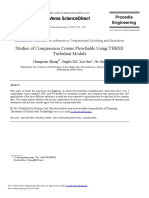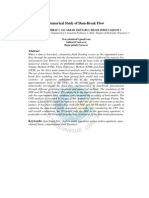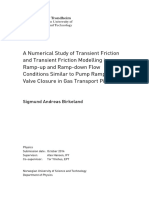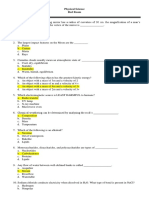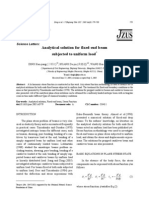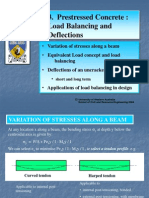Numerical Modeling For Simulation Transient Flow in Distribution System With Crank-Nicolson Method
Numerical Modeling For Simulation Transient Flow in Distribution System With Crank-Nicolson Method
Copyright:
Available Formats
Numerical Modeling For Simulation Transient Flow in Distribution System With Crank-Nicolson Method
Numerical Modeling For Simulation Transient Flow in Distribution System With Crank-Nicolson Method
Original Description:
Original Title
Copyright
Available Formats
Share this document
Did you find this document useful?
Is this content inappropriate?
Copyright:
Available Formats
Numerical Modeling For Simulation Transient Flow in Distribution System With Crank-Nicolson Method
Numerical Modeling For Simulation Transient Flow in Distribution System With Crank-Nicolson Method
Copyright:
Available Formats
(Manuscript No: I12528-09) April 18, 2012 / Accepted: April 24, 2012
Numerical Modeling for Simulation Transient Flow in Distribution System with CrankNicolson Method
Mehdi Salmanzadeh* Department of Mechanical Engineering Shoushtar Branch, Islamic Azad University Shoushtar, Iran phone: +98 916 611 2703 (Email: Mehdi2852003@yahoo.com)
Abstract - For most piping systems the maximum and minimum operating pressures occur during transient operations. Therefore it is essential to good design and operation to perform a transient analysis for normal startup and shutdown and for unplanned events such as a pump trip associated with a power outage. This author also claims that water hammer (transient) analysis is easy. Hydraulic engineers who have studied the traditional approach to transient analysis might dispute this claim but, in fact, carrying out an analysis using the concept of pressure wave action provides an accurate, intuitive, and simple method for transient pipe system analysis of simple or complex pipe systems. Not only is this approach simple, it is extremely efficient producing accurate solutions with far fewer calculations making this approach suitable for analyzing large pipe distribution systems. Keywords: Transient flow, Crank-Nicolson method, water hammer, Pipelines system, Numerical model. Introduction THE basic unsteady flow equations along pipe due to closing of the valve near the turbine are non-linear and hence analytical solutions are not possible. Allevi [1, 2] developed classical solutions by both analytical and graphical methods neglecting the. Bergeron [3, 4] also developed graphical solution. Graphical solutions mentioned above had some practical application in pipe design before the advent of computer. Streeter [5] developed a numerical model by using a constant value of turbulent friction factor. Wiggert and Sundquist [6] solved the pipeline transients using fixed grids projecting the characteristics from outside the fundamental grid size. Their analysis shows the effects of interpolation, spacing, and grid size on numerical attenuation and dispersion. Watt et al [7] have solved for rise of pressure by MOC for only 1.2 seconds and the transient friction values have not been considered. Goldberg and Wylie [8] used the interpolations in time, rather than the more widely used spatial interpolations, demonstrates several benefits in the application of the method of characteristics to wave problems in hydraulics .Shimada and Okushima[9] solved the second order equation of water hammer by a series solution method and a Newton Raphson method. They calculated only maximum water hammer pressure with constant friction factor. The solution was not carried out for sufficiently long time to demonstrate damping of pressure head with increase of time. Chudhury and Hussaini [10] solved the water hammer equations by MacCormack, Lambda, and Gabutti explicit FD schemes. I. A. Sibetheros et al. [11] investigated the method of characteristics (MOC) with spline polynomials for interpolations required in numerical water hammer analysis for a frictionless horizontal pipe Silva-Arya and Choudhury [12] solved thehyperbolic part of the governing equation by MoC in one dimensional form and the parabolic part of the equation by FD in quasi-two-dimensional form. Pezzinga [13] presented both quasi 2-D and 1-D unsteady flow analysis in pipe and pipe networks using finite difference implicit scheme. Head oscillations were solved only for 4 seconds with constant friction. Pezzinga [14] also worked to evaluate the unsteady flow resistance by MoC. He used Darcy-Weisback formula for friction and solved for head oscillations up to 4 seconds only. Damping with constant friction factor is presented but not much pronounced, as the solution time is very small. Ghidaoi and Kolyshkin [15] performed linear stability analysis of base flow velocity profiles for laminar and turbulent water-hammer flows. They found that the main parameters that govern the stability behavior of the transient flows are the Reynolds numbers and the dimensionless timescale and the results found were plotted in Reynolds number / timescale space. Ghidaoui etal [16] implemented and analyzed the two layer and the five layer eddy viscosity models of water hammer. A dimensionless parameter i.e., the ratio of the time scale of the radial diffusion of shear to the time scale of wave propagation has been developed for assessing the accuracy of 1
International Journal Of Structronics & Mechatronics
the assumption of flow axisymmetry in both the models of water hammer. Zhao and Ghidaoui [17] have solved a quasi-two dimensional model for turbulent flow in water hammer. They have considered turbulent shear stress as resistance instead of friction factor. Bergant [18] et al incorporated two unsteady friction models proposed by Zielke [19] and Brunone [20] et al. into MOC water hammer analysis. The numerical results obtained for pressure heads, at valve section and in the mid-section up to 1 sec, from the quasi-steady friction model, Zielke model and Brunone model have been compared with the results ofmeasurements of fast valve closure in a laboratory apparatus with laminar flow and low Reynolds numbers turbulent flow condition. Zhao and Ghidaoui [21] formulated, applied and analyzed first and second order explicit finite volume (FV) Godunov-type schemes for water hammer problems. They have compared both the FV schemes with MOC considering space line interpolation for three test cases with and without friction for Courant numbers 1, 0.5.0.1.They modeled the wall friction using the formula of Brunone [20] et al. It has been found that the First order FV Gadunov scheme produces identical results with MOC considering space line interpolation. Hence the study of the previous works denotes that there are various numerical models, which include Method of characteristics (MOC), Finite Difference (FD) and Finite Volume (FV), presented by different investigators to obtain the transient pressure and discharges in water hammer situations. Among these methods MOC proved to be the most popular one as out of 14 commercially available water hammer software found on the World Wide Web, 11 are based on MOC and 2 are based on FD. Again the fixed grid MOC is most widely accepted being simple to code, accurate, efficient. Zhao and Ghidaoui21 advocated that although different approaches such as FV, MOC, FD and finite element (FE) provide an entirely different framework for conceptualizing and representing the physics of the flow, the schemes that result from different approaches can be similar and even identical. A numerical model UNSTD_FRIC_ BRR_WH using MOC and Barrs explicit friction factor has been presented here for solution of the transient flow situations of water hammer where there is a provision of computation of the transient frictions along with the pressure and discharges at a particular pipe section. Assessment of friction at any section in this unsteady transient flow condition also clearly indicates the effectiveness of using variable friction factor in contrast to the steady state friction as in the available numerical models. Damping of pressure and discharge with time after valve closure due to friction of the pipe are clearly illustrated by UNSTD_FRIC_WH model. It is well applicable for all flow conditions ranging from laminar to turbulent. GOVERNING EQUATIONS FOR STEADY-STATE FLOW In addition to pressure head, elevation head, and velocity head, there may also be head added to the system, for instance, by a pump, and head removed from the system by friction. These changes in head are referred to as head gains and head losses, respectively balancing the energy across two points in the system yields the energy or Bernoulli equation for steady-state flow: 1. CONTINUITY EQUATION FOR UNSTEADY FLOW The continuity equation for a fluid is based on the principle of conservation of mass. The general form of the continuity equation for unsteady fluid flow is as follows: 2. The second term on the left-hand side of the preceding equation is small relative to other terms and is typically neglected, yielding the following simplified continuity equation, as used in the majority of unsteady models: 3. MOMENTUM EQUATION FOR UNSTEADY FLOW The equations of motion for a fluid can be derived from the consideration of the forces acting on a small element, or control volume, including the shear stresses generated by the fluid motion and viscosity. The threedimensional momentum equations of a real fluid system are known as the Navier- Stokes equations. Since flow perpendicular to pipe walls is approximately zero, flow in a pipe can be considered one-dimensional, for which the continuity equation reduces to: 2
Mehdi Salmanzadeh
4.
| |
The last term on the left-hand side represents friction losses in the direction of flow: | | CRANKNICOLSON METHOD(C-N method) In numerical analysis, the CrankNicolson method is a finite difference method used for numerically solving the heat equation and similar partial differential equations. It is a second-order method in time, implicit in time, and is numerically stable. The method was developed by John Crank and Phyllis Nicolson in the mid-20th century. For diffusion equations (and many other equations), it can be shown the CrankNicolson method is unconditionally stable. However, the approximate solutions can still contain (decaying) spurious oscillations if the ratio of time step to the square of space step is large (typically larger than 1 / 2). For this reason, whenever large time steps or high spatial resolution is necessary, the less accurate backward Euler method is often used, which is both stable and immune to oscillations. The CrankNicolson method is based on central difference in space and the trapezoidal rule in time, giving second-order convergence in time. Equivalently, it is the average of forward Euler and backward Euler in time. For example, in one dimension, if the partial differential equation is
Then, letting, the CrankNicolson method is the average of the forward Euler method at n and the backward Euler method at n + 1:
Figure 1 : The Crank-Nicolson stencial for a 1D problem
Crank-Nicolson * ( ) ( )+
The function F must be discretized spatially with a central difference. Note that this is an implicit method: to get the "next" value of u in time, a system of algebraic equations must be solved. If the partial differential equation is nonlinear, the discretization will also be nonlinear so that advancing in time will involve the solution of a 3
International Journal Of Structronics & Mechatronics
system of nonlinear algebraic equations, though linearizations are possible. In many problems, especially linear diffusion, the algebraic problem is tridiagonal and may be efficiently solved with the tridiagonal matrix algorithm, avoiding a costly full matrix inversion. In the C-N method the partial differential equations transforms into ordinary differential equations along characteristics line. Equations 3 and 4 are presented as the following finite difference equations for pressure head H and velocity V:
Equations 3 and 4 are presented as the following finite difference equation. P = gh 5. 6. ( ( ) ) ( ( ) ) | |
Solve equation 5 and 6 for head H and velocity V: 7. 8. | |
The friction factor f in the above equations 3 to 8 is replaced by the following Churchill explicit approximations which covers full range of flow conditions, from laminar to turbulent. f = 8[( ) ]
A=*
, B=(
PERFORMANCES FOR A SAMPLE PIPELINE IN COMPARISON WITH C-N METHOD OUTPUTS AND HAMMER 7.0 he proposed model was examined for rapid valve closing in downstream of a long conduit with a infinite reservoir upstream The stability and accuracy of the solutions are tested by comparing them with the solutions obtained by an another numerical method C-N method and solutions already available in literature for that pipe system by water hammer program. The numerical values taken to start the solution of the physical problem are: l = 3657m D = 0.609m f = 0.02 = 0.0022mm Time = 4 sec x = 914.25m pipe length diameter of the pipe steady state friction factor roughness size of the pipe valve closure time pipe is divided into=4 sections 4
Mehdi Salmanzadeh
182.80 m
infinite reservoir with steady
Q = 0.3398 volume flow rate s m a = 914 m/s velocity of pressure wave after valve closure h1 = 182.8 m, h2 = 179.7 m, h3 = 176.6 m, h4 = 173.6 m, h5= 170.6 m v = 0.000005 m2/s viscosity of water
Figure 2- Schematic of hydraulic system considered for the case study.
To investigate the accuracy of the proposed methods in the previous section and select the top several methods which have the problem mended analytical solutions were considered. For solving these problems by numerical method a computer program in Pascal language was written that the results of numerical methods are the output of the mentioned program. Then the analytical solutions are compared with numerical methods. It's obvious that a method enjoys superiority that to some extent its results are closer to the results of analytical methods.
Figure 3- Pressure head at junction 5 wait C-N method and hammer 7.0
International Journal Of Structronics & Mechatronics
Figure 4- Volume flow rate at junction 5 wait C-N method and hammer 7.0
Figure 5- Pressure head at junction 3 wait C-N method and hammer 7.0
Mehdi Salmanzadeh
Figure 6- Volume flow rate at junction 5 wait C-N method and hammer 7.0
Figure 7- Volume flow rate at near the tank wait C-N method and hammer 7.0
Conclusion Transient (waterhammer) analysis is essential to good design and operation of piping systems. This important analysis can be done using the mathematically based C-N method based on the action of pressure waves. The CN methods are both capable of accurately solving for transient pressures and flows in water distribution networks including the effects of pipe friction. Therefore, for the same modeling accuracy the C-N method will normally require fewer calculations and faster execution times.
International Journal Of Structronics & Mechatronics
References 1. L.Allevi. 1904. Theorie general du movement varie de leau dans less tuyaux de conduit. Revue de Mecanique, Paris, France. Vol. 14(Jan-Mar): 10-22 and 230-259. L.Allevi. 1932. Colpo dariete e la regolazione delle turbine. Electtrotecnica. Vol. 19, p. 146. L Bertgeron. 1935. Estude ds vvariations de regime dans conduits deau:Solution graphique general e. Revue General de lHydraulique. Vol. 1, pp. 12 and 69. L Bergeron. 1936. Estude des coups de beler dans les conduits, nouvel exose de la methodegraphique. La Technique Moderne. Vol. 28, pp. 33,75. V.L.Streeter. 1969. Water Hammer Analysis. Journal of Hy. Div. ASCE. Vol. 95, No. 6, November. D. C.Wiggert, M. J Sundquist. 1977. Fixed-Grid Characteristics for Pipeline Transients. Journal of Hy. Div. ASCE. Vol. 103(12): 1403-1416. C.S Watt., J.M. Hobbs and A.P Boldy. 1980. Hydaulic Transients Following Valve Closure. Journal Hy. Div. ASCE. Vol. 106(10): 1627-1640. D. E.Goldberg, B.Wylie. 1983. Characteristics Method Using Time-Line Interpolations. Journal Hy. Div. ASCE. Vol. 109(5): 670-683. M Shimada and S Okushima. 1984. New Numerical Model and Technique for Water Hammer.Eng. Journal Hy. Div. ASCE. Vol. 110(6): 730-748.
2. 3.
4.
5. 6.
7.
8.
9.
10. M.H.Chudhury,and M.Y.Hussaini. 1985. Second-order accurate explicit finitedifference schemes for water hammer analysis. Journal of fluid Eng. Vol. 107. pp. 523-529. 11. I. A Sibetheros, E. R Holley and J. M Branski. 1991. Spline Interpolations for Water Hammer Analysis. Journal of Hydraulic Engineering. Vol. 117(10): 1332-1351. 12. W.F Silva-Arya, and M.H.Chaudhury. 1997. Computaion of enegu dissipation in transient flow. Journal Hydraulic Engineering, ASCE. Vol. l123(2): 108-115. 13. G Pezzzinga. 1999. Quasi-2D Model for Unsteady Flow in pipe networks. Journal of Hydraulic Engineering, ASCE. Vol. 125(7): 666-685. 14. G Pezzinga. 2000. Evaluation of Unsteady Flow Resistance by quasi-2D or 1D Models. Journal of Hydraulic Engineering. Vol. l126(10): 778-785. 15. M.S.Ghidaoui and A.A.Kolyshkin. 2001. Stability Analysis of Velocity Profiles in Water-Hammer Flows. Vol. 127(6): 499-512. 16. M.S Ghidaoui., G.S. Mansour and M. Zhao. 2002. Applicability of Quasissteady and Axisymmetric Turbulence Models in Warter Hammer. Journal of Hydraulic Engineering, ASCE. Vol. l128(10): 917-924. 17. M Zhao. and M.S Ghidaoui. 2003. Efficient Quasi-Two dimension Model for Water Hammer Problems. Journal of Hydraulic Engineering, ASCE. Vol. l129(12): 1007-1013. 18. A.Bergant, AR Simpson and J Vitekovsky. 2001. Developments in unsteady pipe flow friction modeling. Journal of Hydraulic Research. Vol. 39(3): 249-257. 19. W.Zielke. 1968. Frequency -dependent Friction in Transient pipe flow. Journal of Basic Eng, ASME. Vol. l 90(9): 109-115. 20. B. Brunone, U.M Golia,.,and M.Greco. 1991. Some remarks on the momentum equation for fast transients. Proc. Int. Conf. on Hydraulic transients with water column separation, IAHR, Valencia, Spain. Pp. 201-209. 8
Mehdi Salmanzadeh
21. M.Zhao, and M.S Ghidaoui. 2004. Godnouv-Type Solutions for Water Hammer Flows. Journal of hydraulic Engineering, ASCE. Vol. l130(4): 341-348.
You might also like
- Pressure Loss Equations PDFDocument18 pagesPressure Loss Equations PDFcperez10000No ratings yet
- EEC 122 CompleteDocument34 pagesEEC 122 CompleteAdeniji OlusegunNo ratings yet
- Numerical Modelling of Transient Flow in Long Oil Pipe Line SystemDocument33 pagesNumerical Modelling of Transient Flow in Long Oil Pipe Line SystemlsaishankarNo ratings yet
- CFD Ball ValveDocument8 pagesCFD Ball ValveKelvin Octavianus DjohanNo ratings yet
- Comparative StudyDocument12 pagesComparative StudyAvinash VasudeoNo ratings yet
- International Journal of Computational Engineering Research (IJCER)Document19 pagesInternational Journal of Computational Engineering Research (IJCER)International Journal of computational Engineering research (IJCER)No ratings yet
- A Comparative Study of Turbulence Models Performance For Turbulent Flow in A Planar Asymmetric DiffuserDocument12 pagesA Comparative Study of Turbulence Models Performance For Turbulent Flow in A Planar Asymmetric DiffuserMukesh BohraNo ratings yet
- The Influence of Knudsen Number On The Hydrodynamic Development Length Within Parallel Plate Micro-ChannelsDocument10 pagesThe Influence of Knudsen Number On The Hydrodynamic Development Length Within Parallel Plate Micro-ChannelsChong Jen HawNo ratings yet
- Exact Navier - Stokes Solution For Pulsatory Viscous Channel Flow With Arbitrary Pressure GradientDocument12 pagesExact Navier - Stokes Solution For Pulsatory Viscous Channel Flow With Arbitrary Pressure GradientMoneeza BatoolNo ratings yet
- Star CCM Global Conference 22 PaperDocument17 pagesStar CCM Global Conference 22 PaperSruti SmritiNo ratings yet
- Mathematical Modeling For Water Hammer in Pipe Flow: Dr. Qassem H. Jalut, Nisreen J. RasheedDocument14 pagesMathematical Modeling For Water Hammer in Pipe Flow: Dr. Qassem H. Jalut, Nisreen J. RasheedAKHILESH PASWANNo ratings yet
- CFD FinalDocument17 pagesCFD FinalSameer NasirNo ratings yet
- Experimental and Numerical Analysis of Different Aerodynamic Properties of Circular CylinderDocument6 pagesExperimental and Numerical Analysis of Different Aerodynamic Properties of Circular Cylinderpramo_dassNo ratings yet
- Impact of Pipes Networks Simplification On Water Hammer PhenomenonDocument18 pagesImpact of Pipes Networks Simplification On Water Hammer PhenomenonVelpandian ManiNo ratings yet
- Numerical Simulation of Cavitating Turbulent Flow in A High Head Francis Turbine at Part Load Operation With OpenfoamDocument10 pagesNumerical Simulation of Cavitating Turbulent Flow in A High Head Francis Turbine at Part Load Operation With OpenfoamdharmeswarNo ratings yet
- Report7 UpdatedDocument21 pagesReport7 UpdatedSameer NasirNo ratings yet
- Water: Experimental and Numerical Simulation of Water Hammer in Gravitational Pipe Flow With Continuous Air EntrainmentDocument16 pagesWater: Experimental and Numerical Simulation of Water Hammer in Gravitational Pipe Flow With Continuous Air EntrainmentskyNo ratings yet
- Studies of Compression Corner Flowfields Using THREE Turbulent ModelsDocument7 pagesStudies of Compression Corner Flowfields Using THREE Turbulent Modelsarnalt_stalinNo ratings yet
- Flow Over A CylinderDocument14 pagesFlow Over A CylinderHariVathsalaNo ratings yet
- Transient Flows in A Pipe System With Pump Shut-DoDocument11 pagesTransient Flows in A Pipe System With Pump Shut-DoSuresh CNo ratings yet
- RotametreDocument9 pagesRotametreJohn AdewaleNo ratings yet
- Zawawi 2018Document9 pagesZawawi 2018mohamedbelhajm540No ratings yet
- CFD Simulation of The Solid-Liquid Slurry FLow in A Pipeline (Ej) (NABIL, T El-SAWAF, I. El-NAHHAS, K.) (17th Int. Water Techn. Conf. IWTC17 2013) (14s)Document14 pagesCFD Simulation of The Solid-Liquid Slurry FLow in A Pipeline (Ej) (NABIL, T El-SAWAF, I. El-NAHHAS, K.) (17th Int. Water Techn. Conf. IWTC17 2013) (14s)R_M_M_No ratings yet
- Coupled Fluid Structure Interaction Analysis On A Cylinder Exposed To Ocean Wave LoadingDocument82 pagesCoupled Fluid Structure Interaction Analysis On A Cylinder Exposed To Ocean Wave LoadingZachary ChandlerNo ratings yet
- Fric Flow Ours FINAL VR 2Document14 pagesFric Flow Ours FINAL VR 2Edwin Jesu DassNo ratings yet
- Numerical Study of Dam-Break Flow - Omid SeyedashrafDocument9 pagesNumerical Study of Dam-Break Flow - Omid SeyedashrafseyedashrafNo ratings yet
- CFD Analysis and Model Comparison of Annular Frictional Pressure Losses While Circulating Yield Power Law Fluids - SPE-173840-MSDocument22 pagesCFD Analysis and Model Comparison of Annular Frictional Pressure Losses While Circulating Yield Power Law Fluids - SPE-173840-MSUser UserNo ratings yet
- Aplicabilidad de URANS y DES Simulaciones de Flujo Pasado Cilindros Rectangulares y Secciones PuenteDocument30 pagesAplicabilidad de URANS y DES Simulaciones de Flujo Pasado Cilindros Rectangulares y Secciones PuenteDaniel SCNo ratings yet
- Calculo de F en Zona TransicionDocument12 pagesCalculo de F en Zona TransicionmolcitoNo ratings yet
- Khani Et Al 10 (12) 2022Document17 pagesKhani Et Al 10 (12) 2022JanezNo ratings yet
- A CFD-based Wind Solver For An Urban Fast Response Transport and Dispersion ModelDocument26 pagesA CFD-based Wind Solver For An Urban Fast Response Transport and Dispersion ModelMarco Della PelleNo ratings yet
- Water: Calibration Procedure For Water Distribution Systems: Comparison Among Hydraulic ModelsDocument18 pagesWater: Calibration Procedure For Water Distribution Systems: Comparison Among Hydraulic ModelsWaheed AhmadNo ratings yet
- Comparison of LES and RANS Calculations of The Flow Around Bluff BodiesDocument21 pagesComparison of LES and RANS Calculations of The Flow Around Bluff BodiesMahrukh ZAIDINo ratings yet
- Ijet V3i6p84Document6 pagesIjet V3i6p84International Journal of Engineering and TechniquesNo ratings yet
- Chapter 2 Rainfall Runoff RelationshipsDocument30 pagesChapter 2 Rainfall Runoff RelationshipsandexNo ratings yet
- Ai Et Al, 2010 - Non Hydro Static 3dDocument17 pagesAi Et Al, 2010 - Non Hydro Static 3ddavidddumbaNo ratings yet
- Mass Flow Rate Measurement of Gas/Liquid Two-Phase Flow in Horizontal Pipe Based On V-Cone Flow Meter and Adaptive Wavelet NetworkDocument6 pagesMass Flow Rate Measurement of Gas/Liquid Two-Phase Flow in Horizontal Pipe Based On V-Cone Flow Meter and Adaptive Wavelet NetworkFernando GuerreroNo ratings yet
- Study On Flow Dynamic Characteristic of BladderDocument13 pagesStudy On Flow Dynamic Characteristic of BladderhbshinNo ratings yet
- ART20178896Document8 pagesART20178896Phạm PhátNo ratings yet
- Approximate Approach For Improving Pressure AttenuDocument12 pagesApproximate Approach For Improving Pressure AttenuBadreddine EssaidiNo ratings yet
- galusinski2008Document25 pagesgalusinski2008divyeshmajithia997No ratings yet
- Phan-Thien-Tanner Modeling of A Viscoelastic Fluid Flow Around A Cylinder in A DuctDocument17 pagesPhan-Thien-Tanner Modeling of A Viscoelastic Fluid Flow Around A Cylinder in A DuctJJ SerraltaNo ratings yet
- Sample CFD PaperDocument7 pagesSample CFD PaperNurikNo ratings yet
- Prediction of Two-Phase Pipe Flows Using Simple Closure Relations in A 2D Two-Fluid ModelDocument13 pagesPrediction of Two-Phase Pipe Flows Using Simple Closure Relations in A 2D Two-Fluid Modelvivek9199No ratings yet
- MSC - Nastran Aeroelasticity PDFDocument8 pagesMSC - Nastran Aeroelasticity PDFDandyelEleusisNo ratings yet
- Mithal Okab AbdulhadiDocument7 pagesMithal Okab AbdulhadiOmar AbooshNo ratings yet
- Water 10 01652 PDFDocument19 pagesWater 10 01652 PDFArun GangwarNo ratings yet
- Hanjalic-Launder JFM Vol52 1972Document30 pagesHanjalic-Launder JFM Vol52 1972LucaNo ratings yet
- A Numerical Study of Transient Friction and Transient Friction Modelling in Ramp-Up and Ramp-Down Flow Conditions Similar To Pump Ramp-Up and Valve Closure in Gas Transport PipelinesDocument153 pagesA Numerical Study of Transient Friction and Transient Friction Modelling in Ramp-Up and Ramp-Down Flow Conditions Similar To Pump Ramp-Up and Valve Closure in Gas Transport PipelineshjxyNo ratings yet
- Tigist CFD Lab ReportDocument23 pagesTigist CFD Lab Reportdaniel hambissaNo ratings yet
- Investigation of Newtonian Fluid Flow Through A Two-Dimensional Sudden Expansion and Sudden Contraction Flow PassageDocument9 pagesInvestigation of Newtonian Fluid Flow Through A Two-Dimensional Sudden Expansion and Sudden Contraction Flow PassageIJERDNo ratings yet
- Lagrangian Slug Ow Modeling and Sensitivity On Hydrodynamic Slug Initiation Methods in A Severe Slugging CaseDocument11 pagesLagrangian Slug Ow Modeling and Sensitivity On Hydrodynamic Slug Initiation Methods in A Severe Slugging CasefanziskusNo ratings yet
- 307王磊Document9 pages307王磊Emmanuel RoblesNo ratings yet
- Research Article: CFD Analysis of The Effect of Elbow Radius On Pressure Drop in Multiphase FlowDocument9 pagesResearch Article: CFD Analysis of The Effect of Elbow Radius On Pressure Drop in Multiphase FlowkkkprotNo ratings yet
- HEM ModelDocument59 pagesHEM ModelPaolo MocellinNo ratings yet
- Water: An Artificial Compressibility Method For 1D Simulation of Open-Channel and Pressurized-Pipe FlowDocument33 pagesWater: An Artificial Compressibility Method For 1D Simulation of Open-Channel and Pressurized-Pipe FlowVivekNo ratings yet
- International Journal of Numerical Methods For Heat & Fluid FlowDocument22 pagesInternational Journal of Numerical Methods For Heat & Fluid FlowharshalsparksNo ratings yet
- Water NicollaDocument31 pagesWater NicollaNikola BoskovicNo ratings yet
- Couchesne Laneville1982Document6 pagesCouchesne Laneville1982ThejaswiniNo ratings yet
- Mathematical Aspects of Subsonic and Transonic Gas DynamicsFrom EverandMathematical Aspects of Subsonic and Transonic Gas DynamicsRating: 5 out of 5 stars5/5 (2)
- Mixing PDFDocument38 pagesMixing PDFSummaiya Kakakheil100% (2)
- 200 Questions in Physical ScienceDocument21 pages200 Questions in Physical ScienceROSENDA CORRALNo ratings yet
- Periodic Properties PDFDocument14 pagesPeriodic Properties PDFSaksham Bejwani100% (1)
- HSDT Test SpecificationDocument32 pagesHSDT Test SpecificationRaja RajanNo ratings yet
- Membrane Technology: (PEC-CH311)Document17 pagesMembrane Technology: (PEC-CH311)Abhinandan GayakiNo ratings yet
- Boyle's Law LabDocument4 pagesBoyle's Law LabJace DuleyNo ratings yet
- Crack Analysis in AnsysDocument13 pagesCrack Analysis in AnsysDav89No ratings yet
- Chapter 5 - Partial DerivativesDocument23 pagesChapter 5 - Partial Derivativesdbreddy287No ratings yet
- Rajeev - Advanced Classical Mechanics (Chaos) (Eng)Document100 pagesRajeev - Advanced Classical Mechanics (Chaos) (Eng)aanjaneyakNo ratings yet
- Ieee PDFDocument7 pagesIeee PDFHerlin AgustinaNo ratings yet
- PCM Jee M ScheduleDocument14 pagesPCM Jee M ScheduleShubhankar PandeyNo ratings yet
- By Vicki - The Science Lady: Atomic StructureDocument3 pagesBy Vicki - The Science Lady: Atomic StructureLeila BawabNo ratings yet
- PreviewDocument72 pagesPreviewalberickmimeNo ratings yet
- Analytical Solution For Fixed-End Beam Subjected To Uniform LoadDocument5 pagesAnalytical Solution For Fixed-End Beam Subjected To Uniform Loadtalal2124100% (1)
- Conduct Branch-IDocument5 pagesConduct Branch-IYashika BatraNo ratings yet
- Chapter 6: Solution Thermodynamics and Principles of Phase EquilibriaDocument51 pagesChapter 6: Solution Thermodynamics and Principles of Phase EquilibriaayushNo ratings yet
- Basic Thermodynamics: Module 01: Fundamental Concepts and Definitions 1.1 DefinitionDocument22 pagesBasic Thermodynamics: Module 01: Fundamental Concepts and Definitions 1.1 DefinitionVinayaka G PNo ratings yet
- Aseffa Sosena Physics-Lab9-Report XXXDocument5 pagesAseffa Sosena Physics-Lab9-Report XXXapi-242490990No ratings yet
- Fluid Mechanics Tutorial No.4 Flow Through Porous PassagesDocument8 pagesFluid Mechanics Tutorial No.4 Flow Through Porous PassagesGeorge OparNo ratings yet
- Unit 4 - Forces and EnergyDocument7 pagesUnit 4 - Forces and EnergyboggaliveNo ratings yet
- Electrical Thumb Rules (Part 3)Document3 pagesElectrical Thumb Rules (Part 3)Himdad TahirNo ratings yet
- Second Order Under Damped System DynamicsDocument6 pagesSecond Order Under Damped System DynamicsRahul PancholiNo ratings yet
- Prestressed Concrete: Load Balancing and DeflectionsDocument20 pagesPrestressed Concrete: Load Balancing and Deflections16052169No ratings yet
- EdExcel A Level Chemistry Unit 5 Mark Scheme Jan 2000Document3 pagesEdExcel A Level Chemistry Unit 5 Mark Scheme Jan 2000Nabeeha07No ratings yet
- NucleosynthesisDocument4 pagesNucleosynthesisBerenice PantiiNo ratings yet
- HMT Obj Hand Book IDocument10 pagesHMT Obj Hand Book Ianikka reenaNo ratings yet
- Answersheet 12Document2 pagesAnswersheet 12Ahmed MohsenNo ratings yet
- AGT Module 3Document33 pagesAGT Module 3VEERKUMARNo ratings yet
- Ionic CompoundsDocument2 pagesIonic CompoundsShenneth De CastroNo ratings yet

















